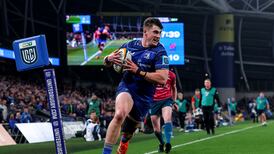"L'audace, l'audace, toujours l'audace!" French-speaking Joe Schmidt will know what General George Patton was saying: "Audacity, audacity, always audacity!" Patton uttered these words while lying on a chaise longue deep in Sicily as US general Lucian King Truscott begged for a reprieve for his exhausted troops. But "old blood and guts" was in no mood to take his foot off Truscott's army, less so off the retreating Axis soldiers and was especially determined to capture Messina before Monty and his British 8th Army arrived.
Never before have we been in this position. Never before in our entire history, the history of the oldest international rugby ground have we the opportunity to go back-to-back with the All Blacks. So, do we dig in or do we attack?
As noted last Friday what worked in Chicago will not guarantee a win on Saturday. Why not? Well much of my perception of their weakness in Chicago centred on their loss of secondrows Brodie Retallick and Sam Whitelock. For instance, Ireland’s defence systems are linked to the return of the beanpoles. Pressure in the set piece reduced All Black potential in green grass.
Sloppiness spread
For every action there is an equal and opposite reaction and as their lineout crumbled – due to Ireland’s ability in the air and New Zealand’s lack of real options – the ball became crap and the backline, as brilliant as they can be, were pedestrian and, most interestingly, sloppiness spread. Stop that problem at source and New Zealand transform their attack.
Furthermore, All Black scrumhalf Aaron Smith appeared to be most impacted by the disjointed nature of New Zealand in Chicago. The most obvious sign – his defence at the base of a ruck, was spotted and exposed by Conor Murray. But watch Smith off a free-flowing attacking lineout. He will typically set in the front prop position as his openside Sam Cane slots into the traditional scrumhalf spot. I beg you to keep your eyes on Smith as the ball is floated in by Dane Coles and continue to watch him as he peels around receiving the ball. Then watch the array of options available to him beyond the lineout and watch him select and execute the crispest pass to a myriad of potential receivers.
This process is deadly, but in Chicago it lay dormant. Retallick and Whitelock will breathe life into it once more.
From their phase play they like to get powerful blindside flanker Jerome Kaino onto the second carry into midfield. Kaino is rarely fettered with the engine room role bar closing out games. But in Chicago moving him into the “row” had two terrible impacts: poor first phase and poor third phase. He is out on Saturday. His replacement Liam Squire will fill that role but is a straight line runner which Andrew Trimble punished the last day. Kaino is a huge loss while Seán O’Brien and Iain Henderson will be huge additions.
Energy levels
So with a greater flow of quality ball almost guaranteed from their lineout, what will the All Blacks do? The Italian fixture opens a window to their thought process. Firstly, secure quality ball, then select options to confuse the Irish pressure defence. In essence get them into the grey area of decision-making but at pace and especially off a greater varied Beauden Barrett kicking game.
Expect Ireland’s tackle count to increase which will have an impact on energy levels and error count. This is where Israel Dagg and his new colleagues will expect reward.
Another Irish opportunity in Chicago that has been shut by the return of Retallick and Whitelock is the New Zealand scrum. That phenomenal Robbie Henshaw try came off a powerful Irish scrum tying down the opposition backrow. The effort and energy expended by the tighthead-scrummaging secondrow in support of his tighthead is immense, where only very special athletes such as Paul O’Connell and Malcolm O’Kelly can scrummage and still maraud for 80 minutes. Retallick is another. Although wearing number four, he packs down behind the tighthead.
But deeper is the symbiotic relationship at play. Most, especially referees, expect laboratory conditions for scrummaging. But scrummaging is a living, breathing organism where scenarios change constantly. The English scrum during the last Rugby World Cup was especially slow at adjusting to what the opposition were doing. The answer is found in the hundreds of hours a tighthead and his secondrow spend talking, practising and executing the millions of tiny reactions needed as a pair to get the job done. Retallick and his tighthead Owen Franks have this unique relationship – in Chicago, New Zealand did not.
Cane’s defence off the more settled scrum will improve but expect a sharp and very flat All Black attacking line to test our defence.
Human endeavour
So will Ireland win Saturday’s battle and the series war? Patton noted in Sicily “compared to war all other forms of human endeavour shrink into insignificance”. Well how good are Australia and South Africa at present? Not great.
So if Ireland limit Retallick and Whitelock’s influence, adjust defensively to Barrett’s varied kicking game and if O’Brien can balance breakdown with offloading and Ireland advance their “tip-on” pass then we have a huge opportunity. That’s with home advantage, our fresh squad and O’Brien’s return but especially as New Zealand are and for the first time in their wonderful, illustrious history to us, currently (only briefly) losers.
Ireland, don’t dig in, attack!
liamtoland@yahoo.com









